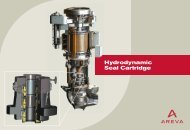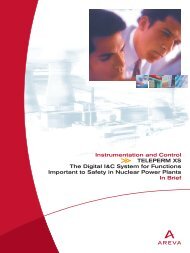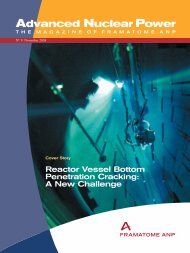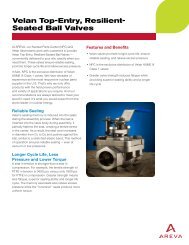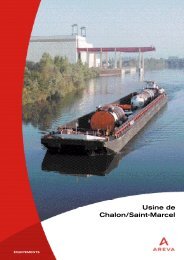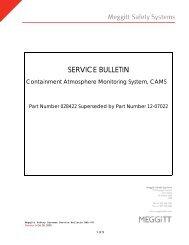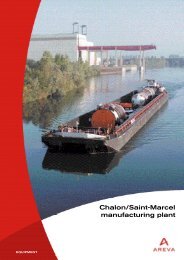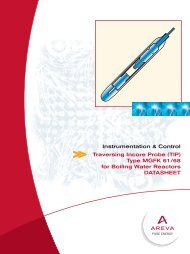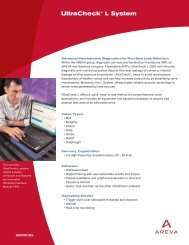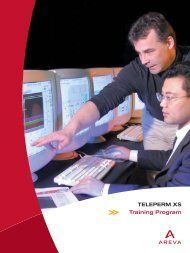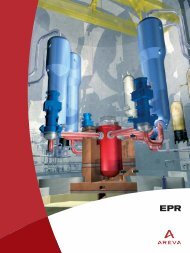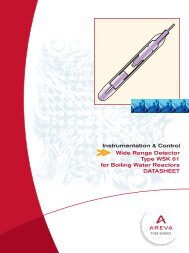Industry InsightsNuclear Generated Hydrogen:A Win/Win SituationDan KeuterIceland has resolved to become theworld’s first economy running entirelyon hydrogen, instead of oil or naturalgas. The President of the EuropeanCommission, the governing body of theEuropean Union, says the EU will spend$2 billion (€1,870,000) to develop ahydrogen future. The US Department ofEnergy is giving millions of dollars to theautomotive industry to develop a fuel cellfor cars. President Bush, in his State ofthe Union address to the US Congress inJanuary, called for “the first car driven bya child born today to be a hydrogen carthat does not pollute the air.”Demand for H2 Growing RapidlyLiquid fuel production is rapidlybecoming major market for H2> 10%/yr*Refining @ ~10% per year growth• X2 current demand by 2010• X4 current demand by 2017That’s huge!*(SSB, DOE, & Industry Sources)Background: Hydrogen, 3D VisualizationThe question is –Where is all thathydrogen coming from? The onlypractical way to produce large volumesof emission-free hydrogen is fromadvanced nuclear reactors.Hydrogen TodayThe current world consumption ofhydrogen is about 40 million tons ayear, 11 million of which is used inthe US. Most hydrogen today isproduced by breaking down naturalgas (methane). But in the steamreformation process, to produce that11 million tons, 74 million tons ofcarbon dioxide is released to theatmosphere every year, worsening thegreenhouse climate change problem.That’s seven tons of pollutants foreach ton of hydrogen.About a third of hydrogen today isused to make ammonia fertilizer forfarms, a third is used in oil refiningto make cleaner gasoline (a growingdemand since the world’s oilrefineries are having to use moreheavy sour crude oil for the lack oflight sweet crude), and a third usedto make methanol, merchant gasand other products.So the more hydrogen made fromnatural gas, the more we are justexchanging one problem (increasingdependence on oil, worsening urban airpollution, Middle East geopolitics) foranother (climate change, increasingdependence on natural gas).The fact is a hydrogen economy onlymakes sense if you have a non-emittingsource of hydrogen. That means usingrenewable energy and nuclear.Renewable Energy forHydrogen ProductionTo generate the equivalent of a typicalnuclear reactor (1,000 megawatts)would require 100 km 2 or 40 squaremiles of photovoltaic solar panels,3,000 windmill turbines at 1,000 kWeach covering 40-70 square miles,30,000 km 2 or 12,000 square miles offorest for wood biomass, 60 millionpigs or 800 million chickens for biogas.By comparison, a nuclear power unitrequires about one square kilometer ora third of a square mile of land area.That is just the land area required.It does not address the questionof whether those renewable energysources can be developed at areasonable cost, nor the lengthof time required for developmentand construction.The truth is the global task of reducinggreenhouse gas at a reasonable costis impossible without building newnuclear power plants. Nuclear is theonly economical source of energy thatdoes not emit carbon dioxide, the chiefgreenhouse gas.The good news is advanced reactorscan do both – produce large volumesof hydrogen at low cost and do itwithout emitting any greenhouse gasor other air pollution (sulfur dioxide,nitrogen oxide or mercury).The FutureEven without whole economies(Iceland, EU, USA) trying to switchfrom oil/gas to hydrogen, the marketdemand for hydrogen is alreadygrowing by 10 percent a year, andis forecast to double by 2010 andquadruple by 2017. That’s huge,6 Advanced Nuclear Power N O 7 April 2003
and that’s mostly hydrogen demandto make cleaner gasoline and relatedliquid fuels, i.e., to sustain thestatus quo.Advanced gas reactors will take 10years to develop too, but the payoffis much bigger.World Consumption of H2 > 40M Tons/Yr.U.S. Consumption > 11M Tons/Yr. (48 GWth)• ~96% produced by steam methane reforming• Consumes 5% of our natural gas• Release 74 M tons of CO2/yrFor example, they are cooled withhelium, an inert, non-corrosive gas withsignificantly less contamination, unlikethe water circulating in today’s lightwater reactors. Second, they can bebuilt underground, making themterrorist hardened. They would bevirtually meltdown proof because oftheir physics. When they get too hot,the chain reaction stops automaticallyand the decay heat dissipates intothe ground around the plant. Noemergency plan beyond the plant’sfence is needed.But the most compelling advantage isthat, like all nuclear energy plants, thereare no air pollutants such as SO2,NOX, mercury or CO2. They alsowould reduce dependence on foreignoil and gas, reducing the world’sdependence on the unstable MiddleEast. And a hydrogen infrastructurewould be a great “battery” for whateversolar and wind power exists by storingtheir energy whenever the sun shines orthe wind blows.Farfetched? Yes, a transition to ahydrogen economy would take years.The good news is advanced nuclearenergy reactors lend themselves to aneasy, gradual transition.For example, today’s gasoline pumpscould be replaced with electrolysisunits, running on electricity and waterand making hydrogen at the stationto put in cars. Electrolysis unitsthemselves have an efficiencyapproaching 80 percent but an overallsystem efficiency of 25-40 percent,compared to the 33-50 percentefficiency of today’s electric system.The implementation could bestaged over time as the numberof hydrogen cars grows.Later advanced reactors which operateat 850-950ºC (1,562 -1,742ºF),compared to today’s light water reactoroperating at 315ºC (599ºF), are hotenough to split water into hydrogenand oxygen in a process calledthermo-chemical splitting. Suchreactors would reach 50 percentefficiency. For the first time, hydrogenwould be created in very large volumesat low cost that could be piped totoday’s gas filling stations.The unique combination of nuclearenergy and hydrogen can solve severalissues at once – energy security anddiversity, clean air, and reducedclimate change. ■Dan Keuter, Vice President of Nuclear Development, EntergyNuclear in Jackson, Mississippi, has been instrumental in growingEntergy Nuclear to its current position as the second largestoperator of nuclear power plants in the US. As Chairman ofthe Utility Advisory Board for an advanced gas-cooled reactor,he has been a strong advocate for the clean generationof hydrogen using nuclear power plants.Advanced Nuclear Power N O 7 April 2003 7



